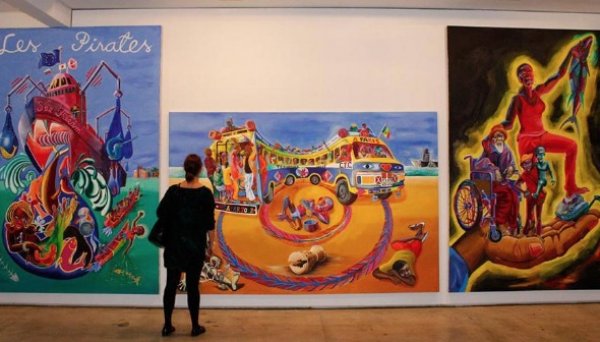
Interesting pyramids … and a huge yellow dog storm the Dakar Corniche: At the much-anticipated Biennale of Contemporary African Art that opened Thursday, artists have taken over public spaces to “tear down walls” museums and galleries, an innovation of this 14th edition.
Facing the magnetic blue of the ocean, residents silently approach two pyramid-shaped shrines. Inside and out, dozens of faces on the floor, eyes closed forever, some screaming. Shoes escape from the shrines, lined up to the edge of the cliff, as if falling into the sea.
A strong invocation and condemnation by the Senegalese artist Yakhia Ba of the tragedies of illegal immigration that afflict many African families.
A little later, selfies are taken of amused residents of a large dog that does not pressure him, the goal of the Egyptian Khaled Zaki, who wanted to delight children and raise the problem of stray dogs in the capital.
Taking down the “walls of galleries and museums”, moving “the artist’s studio to the street” and breaking “the elitist imagination of the city dwellers of art”: the project “Doksanto” (the park, in Wolof language) is a real appeal to art more present in the public space, appealing to the organizers.
Hundreds of exhibits
The bubble capital is known for its creative energy, in a country that has seen the birth of great artists like Osman Sou.
Postponed in 2020 due to Covid, the 14th edition until June 21 welcomes the best contemporary creativity from the continent. The 2018 edition attracted nearly 250 thousand visitors, including more than 50 thousand visitors from abroad.
According to the organizers, “85 countries are represented and more than 2,500 artists are present at home and abroad throughout the territory and in the diaspora.”
Artistic director El Hadj Malek Ndayye was frank in noting that in this poor country “society, after cultural representatives, has not always felt the Biennale,” despite hundreds of exhibitions, open spaces and media coverage. .
17 artists were asked to produce massive works on-site for “dialogue” with venues along the Corniche (fishing village, university, prison, etc.), and scheduled performances “in remote locations” in the capital.
The theme of this edition is “Sandafa (formation in the Wolof)”, “Building new paradigms”.
There are approximately 300 galleries in Dakar and on the islands of Ngor and Goré, about a hundred galleries in other diaspora cities and countries, in the IN program and about 350 projects in the OFF.
“This biennial is symbolically strong because it came after the Covid-19 crisis that shook and tested African countries,” says Mr. Ndiaye in an interview with AFP.
“Africa is at the crossroads of many changes: movements for a new appropriation of African heritage, questions about the CFA franc, about the autonomy of African countries, unrest in many countries, the emergence of a new citizen’s consciousness …”
During this biennale, he said, “Artists are invited to express their own views on all this, forge new ways of thinking, and do everything in their power not to withdraw and not get carried away.”
“make culture rattling”
The international exhibition presents, in a former courtroom with a timeless atmosphere, 59 visual artists of official selection, from 28 countries, including 16 African countries and 12 countries in the diaspora.
Among them, we will be able to challenge the dream-like visions of contemporary African art sensation, Senegalese painter Omar Ba, through a video of South African Sethembile Msezane or an installation transported in Franco-Togolo-Senegal space, Caroline Gay an astrophysicist.
Among other major exhibitions is a “forest” of 343 sculptures – men, women and children, without weapons, as if they were sunken – by Senegalese Ousmane Dia, who denounces inequalities and calls for a new order that is “more focused on human dignity”.
A scientific symposium organized by the writer Floyn Sarr discusses the restoration of African heritage.
“This is the time when the war is taking place on the other side of the world,” Ndiaye said of Russia’s invasion of Ukraine. He urges, “When the guns pop, we should make the culture pop and bet more on it.” (AFP)





More Stories
F-16 crashes in Ukraine – pilot dies due to his own error
Namibia plans to kill more than 700 wild animals to feed starving population
Endurance test for EU-Turkey relations and Ankara with Greece and Cyprus